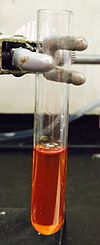Iron pentacarbonyl
 |
|
 |
|
 |
|
| Names | |
|---|---|
|
IUPAC name
pentacarbonyliron
|
|
| Other names
Pentacarbonyl iron
Iron carbonyl |
|
| Identifiers | |
|
3D model (Jmol)
|
|
| ChEBI | |
| ChemSpider | |
| ECHA InfoCard | 100.033.323 |
|
PubChem CID
|
|
| RTECS number | NO4900000 |
| UNII | |
| UN number | 1994 |
|
|
|
|
| Properties | |
| Fe(CO)5 | |
| Molar mass | 195.90 g/mol |
| Appearance | straw-yellow liquid |
| Odor | musty |
| Density | 1.453 g/cm3 |
| Melting point | −21.0 °C (−5.8 °F; 252.2 K) |
| Boiling point | 103 °C (217 °F; 376 K) |
| Insoluble | |
| Solubility | Soluble in organic solvents slightly soluble in alcohol insoluble in ammonia |
| Vapor pressure | 40 mmHg (30.6 °C) |
|
Refractive index (nD)
|
1.5196 (20 °C) |
| Structure | |
| D3h | |
| trigonal bipyramidal | |
| trigonal bipyramidal | |
| 0 D | |
| Hazards | |
| Main hazards | Very toxic, highly flammable |
| Safety data sheet | ICSC 0168 |
|
EU classification (DSD)
|
 
|
| NFPA 704 | |
| Flash point | −15 °C (5 °F; 258 K) |
| 49 °C (120 °F; 322 K) | |
| Explosive limits | 3.7–12.5% |
| Lethal dose or concentration (LD, LC): | |
|
LD50 (median dose)
|
25 mg/kg (rat, oral) |
| US health exposure limits (NIOSH): | |
|
PEL (Permissible)
|
none |
|
REL (Recommended)
|
TWA 0.1 ppm (0.23 mg/m3) ST 0.2 ppm (0.45 mg/m3) |
|
IDLH (Immediate danger)
|
N.D. |
| Related compounds | |
|
Other cations
|
Triruthenium dodecacarbonyl Triosmium dodecacarbonyl |
|
Related iron carbonyls
|
Diiron nonacarbonyl Triiron dodecacarbonyl |
|
Related compounds
|
Dimanganese decacarbonyl Dicobalt octacarbonyl Nickel tetracarbonyl |
|
Except where otherwise noted, data are given for materials in their standard state (at 25 °C [77 °F], 100 kPa).
|
|
|
|
|
| Infobox references | |
Iron pentacarbonyl, also known as iron carbonyl, is the compound with formula Fe(CO)5. Under standard conditions Fe(CO)5 is a free-flowing, straw-colored liquid with a pungent odour. Older samples appear darker. This compound is a common precursor to diverse iron compounds, including many that are useful in small scale organic synthesis.
Iron pentacarbonyl is a homoleptic metal carbonyl; where carbon monoxide is the only ligand complexed with a metal. Other examples include octahedral Cr(CO)6 and tetrahedral Ni(CO)4. Most metal carbonyls have 18 valence electrons, and Fe(CO)5 fits this pattern with 8 valence electrons on Fe and five pairs of electrons provided by the CO ligands. Reflecting its symmetrical structure and charge neutrality, Fe(CO)5 is volatile; it is one of the most frequently encountered liquid metal complexes. Fe(CO)5 adopts a trigonal bipyramidal structure with the Fe atom surrounded by five CO ligands: three in equatorial positions and two axially bound. The Fe–C–O linkages are each linear.
Fe(CO)5 exhibits a relatively low rate of interchange between the axial and equatorial CO groups via the Berry mechanism.
Iron carbonyl is sometimes confused with carbonyl iron, a high-purity metal prepared by decomposition of iron pentacarbonyl.
...
Wikipedia

